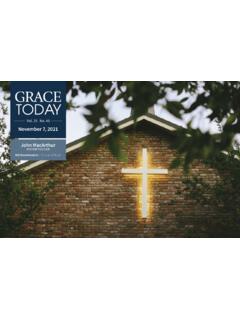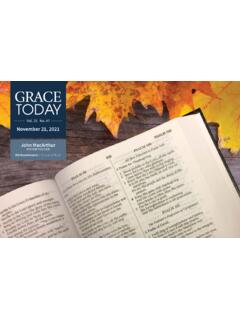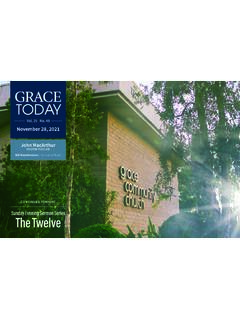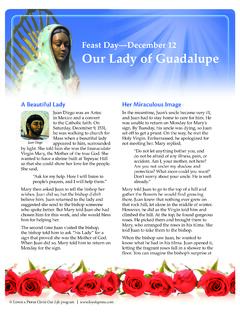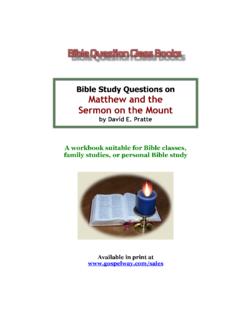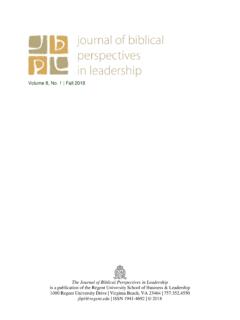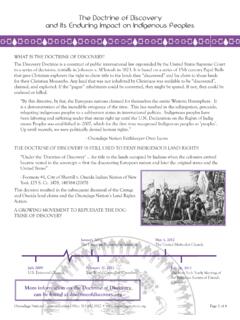Transcription of BWAS Table of Contents - Amazon S3
1 By Water and the Spirit: A United Methodist Understanding of Baptism Table of Contents Note: This Table of Contents was not part of the paper adopted by The General Conference, but is added for convenience of the Church in its study and use of the document. Simply click any section in this Table , and you will go to that section in "By Water and the Spirit." For an additional aid for referencing By Water and the Spirit see the online index. Intro -- 1 We are saved by God s grace -- 3 The Human Condition The Divine Initiative of Grace The Necessity of faith for Salvation The means by which God s grace comes to us Baptism and the life of faith -- 5 Baptism & the life of faith The baptismal covenant Baptism by water and the Holy Spirit Baptism as incorporation into the body of christ Baptism as forgiveness of sin Baptism as new life Baptism and holy living Baptism as god s gift to persons of any age God s faithfulness to the baptismal covenant Nurturing persons in the life of faith Profession of Christian faith and confirmation Reaffirmation of one's profession of Christian faith Baptism in relation to other rites of the church -- 13 Baptism and the Lord s Supper Baptism and Christian Ministry Baptism and Christian Marriage Baptism and Christian Funeral Conclusion -- 15 Copyright 2008 General Board of Discipleship.
2 Do not reproduce without permission. 1 I. Intro 1. Contemporary United Methodism is attempting to recover and revitalize its understanding of baptism. To do this, we must look to our heritage as Methodists and Evangelical United Brethren and, indeed, to the foundations of Christian Tradition. Throughout our history, baptism has been viewed in diverse and even contradictory ways. An enriched understanding of baptism, restoring the Wesleyan blend of sacramental and evangelical aspects, will enable United Methodists to participate in the sacrament with renewed appreciation for this gift of God s grace. 2. Within the Methodist tradition, baptism has long been a subject of much concern, even controversy. John Wesley retained the sacramental theology which he received from his Anglican heritage. He taught that in baptism a child was cleansed of the guilt of original sin, initiated into the covenant with God, admitted into the Church, made an heir of the divine kingdom, and spiritually born anew.
3 He said that while baptism was neither essential to nor sufficient for salvation, it was the ordinary means that God designated for applying the benefits of the work of christ in human lives. 3. On the other hand, although he affirmed the regenerating grace of infant baptism, he also insisted upon the necessity of adult conversion for those who have fallen from grace. A person who matures into moral accountability must respond to God s grace in repentance and faith. Without personal decision and commitment to christ , the baptismal gift is rendered ineffective. 4. Baptism for Wesley, therefore, was a part of the lifelong process of salvation. He saw spiritual rebirth as a twofold experience in the normal process of Christian development -- to be received through baptism in infancy and through commitment to christ later in life. Salvation included both God s initiating activity of grace and a willing human response. 5. In its development in the United States, Methodism was unable to maintain this Wesleyan balance of sacramental and evangelical emphases.
4 Access to the sacraments was limited during the late eighteenth and early nineteenth centuries when the Methodist movement was largely under the leadership of laypersons who were not authorized to administer them. On the American frontier where human ability and action were stressed, the revivalistic call for individual decision-making, though important, was subject to exaggeration. The sacramental teachings of Wesley tended to be ignored. In this setting, while infant baptism continued not only to be practiced, but also to be vigorously defended, its significance became weakened and ambiguous. 6. Later toward the end of the nineteenth century, the theological views of much of Methodism were influenced by a new set of ideas which had become dominant in American culture. These ideas included optimism about the progressive improvement of humankind and confidence in the social benefits of scientific discovery, technology, and education.
5 Assumptions of original sin gave way before the assertion that human nature was essentially unspoiled. In this intellectual milieu, the old evangelical insistence upon conversion and spiritual rebirth seemed quaint and unnecessary. Copyright 2008 General Board of Discipleship. Do not reproduce without permission. 2 7. Thus the creative Wesleyan synthesis of sacramentalism and evangelicalism was torn asunder and both its elements devalued. As a result, infant baptism was variously interpreted and often reduced to a ceremony of dedication. Adult baptism was sometimes interpreted as a profession of faith and public acknowledgment of God s grace, but was more often viewed simply as an act of joining the Church. By the middle of the twentieth century, Methodism in general had ceased to understand baptism as authentically sacramental. Rather than an act of divine grace, it was seen as an expression of human choice. 8. Baptism was also a subject of concern and controversy in the Evangelical and United Brethren traditions that were brought together in 1946 in The Evangelical United Brethren Church.
6 Their early pietistic revivalism, based upon belief in the availability of divine grace and the freedom of human choice, emphasized bringing people to salvation through Christian experience. In the late nineteenth and early twentieth centuries, both Evangelical and United Brethren theologians stressed the importance of baptism as integral to the proclamation of the gospel , as a rite initiating persons into the covenant community (paralleling circumcision), and as a sign of the new birth, that gracious divine act by which persons are redeemed from sin and reconciled to God. The former Evangelical Church consistently favored the baptism of infants. The United Brethren provided for the baptism of both infants and adults. Following the union of 1946, The Evangelical United Brethren Church adopted a ritual that included services of baptism for infants and adults, and also a newly created service for the dedication of infants that had little precedent in official rituals of either of the former churches.
7 9. The 1960-64 revision of The Methodist Hymnal, including rituals, gave denominational leaders an opportunity to begin to recover the sacramental nature of baptism in contemporary Methodism. The General Commission on Worship sounded this note quite explicitly in its introduction to the new ritual in 1964: 10. In revising the Order for the Administration of Baptism, the Commission on Worship has endeavored to keep in mind that baptism is a sacrament, and to restore it to the Evangelical-Methodist concept set forth in our Articles of Religion .. Due recognition was taken of the critical reexamination of the theology of the Sacrament of Baptism which is currently taking place in ecumenical circles, and of its theological content and implications. 11. The commission provided a brief historical perspective demonstrating that the understanding of baptism as a sacrament had been weakened, if not discarded altogether, over the years.
8 Many in the Church regarded baptism, both of infants and adults, as a dedication rather than as a sacrament. The commission pointed out that in a dedication we make a gift of a life to God for God to accept, while in a sacrament God offers the gift of God s unfailing grace for us to accept. The 1964 revision of the ritual of the sacrament of baptism began to restore the rite to its original and historic meaning as a sacrament. 12. In the 1989 The United Methodist Hymnal, the Services of the Baptismal Covenant I, II and IV (taken from the 1984 official ritual of the denomination as printed in The Copyright 2008 General Board of Discipleship. Do not reproduce without permission. 3 Book of Services) continue this effort to reemphasize the historic significance of baptism. These rituals, in accenting the reality of sin and of regeneration, the initiating of divine grace and the necessity of repentance and faith, are consistent with the Wesleyan combination of sacramentalism and evangelicalism.
9 13. United Methodism is not alone in the need to recover the significance of baptism nor in its work to do so. Other Christian communions are also reclaiming the importance of this sacrament for Christian faith and life. To reach the core of the meaning and practice of baptism, all have found themselves led back through the life of the Church to the Apostolic Age. An ecumenical convergence has emerged from this effort, as can be seen in the widely acclaimed document, Baptism, Eucharist and Ministry (1982). 14. Established by the General Conference of 1988 and authorized to continue its work by the General Conference of 1992, the Committee to Study Baptism is participating in this process by offering a theological and functional understanding of baptism as embodied in the ritual of The United Methodist Church. In so doing, the broad spectrum of resources of Scripture, Christian tradition, and the Methodist-Evangelical United Brethren experience has been taken into account.
10 The growing ecumenical consensus has assisted us in our thinking. II. We Are Saved By God s Grace The Human Condition 15. As told in the first chapters of Genesis, in creation God made human beings in the image of God -- a relationship of intimacy, dependence, and trust. We are open to the indwelling presence of God and given freedom to work with God to accomplish the divine will and purpose for all of creation and history. To be human as God intended is to have loving fellowship with God and to reflect the divine nature in our lives as fully as possible. 16. Tragically, as Genesis 3 recounts, we are unfaithful to that relationship. The result is a thorough distortion of the image of God in us and the degrading of the whole of creation. Through prideful overreach or denial of our God-given responsibilities, we exalt our own will, invent our own values, and rebel against God. Our very being is dominated by an inherent inclination toward evil which has traditionally been called original sin.
